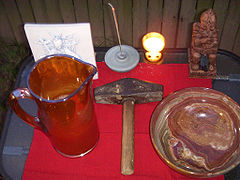
Winter Nights
Encyclopedia

Old Norse
Old Norse is a North Germanic language that was spoken by inhabitants of Scandinavia and inhabitants of their overseas settlements during the Viking Age, until about 1300....
Vetrnætr was a Norse winter festival that was initially celebrated in pre-Christian Scandinavia. It was said by Snorri Sturluson
Snorri Sturluson
Snorri Sturluson was an Icelandic historian, poet, and politician. He was twice elected lawspeaker at the Icelandic parliament, the Althing...
that Winter Nights is one of the three most important festivals. This festival also marks the end of the summer and start of the winter meaning the end of the harvest work and it was a time to celebrate. The festival is celebrated by some Neo-pagans today.
Etymology
The name Vetrnætr is a compound of Old Norse vetr meaning winter, and nætr - the plural form of nátt - meaning nights.Two of the rituals that were held during the festival, álfablót
Álfablót
The Álfablót or the Elven sacrifice was a pagan Scandinavian sacrifice to the elves towards the end of autumn, when the crops had been harvested and the animals were most fat. Unlike the great blóts at Uppsala and Mære, the álfablót was a local celebration at the homesteads and they were mainly...
and Dísablót
Dísablót
The Dísablót was the blót which was held in honour of the female spirits or deities called dísir , from pre-historic times until Christianization in Scandinavia. Its purpose was to enhance the coming harvest. It is mentioned in Hervarar saga, Víga-Glúms saga, Egils saga and the Heimskringla...
, names stem from the Nordic word, blót
Blót
The blót was Norse pagan sacrifice to the Norse gods and the spirits of the land. The sacrifice often took the form of a sacramental meal or feast. Related religious practices were performed by other Germanic peoples, such as the pagan Anglo-Saxons...
, which is a sacrifice to the Norse gods and Elves. Dísablót also derives from the Nordic word Dís
Dis
- Academic institutions :* DIS – Danish Institute for Study Abroad, an English language study abroad program located in Copenhagen, Denmark* Dili International School, DIS an International School in Dili, Timor Leste - Companies :...
.
Worship
Many different beings were worshipped during Winter Nights.Winter Nights was considered a time for remembering the dead and the Norse Gods. A Sacrifice(Blót
Blót
The blót was Norse pagan sacrifice to the Norse gods and the spirits of the land. The sacrifice often took the form of a sacramental meal or feast. Related religious practices were performed by other Germanic peoples, such as the pagan Anglo-Saxons...
) was held to pay respects to the dead. It was also held to thank the Gods for a good harvest year and for more to come.
An Álfablót
Álfablót
The Álfablót or the Elven sacrifice was a pagan Scandinavian sacrifice to the elves towards the end of autumn, when the crops had been harvested and the animals were most fat. Unlike the great blóts at Uppsala and Mære, the álfablót was a local celebration at the homesteads and they were mainly...
was also held by some to worship the Elves, who were a race of beings believed to be powerful and beautiful.
Another sacrificial ritual, a Dísablót
Dísablót
The Dísablót was the blót which was held in honour of the female spirits or deities called dísir , from pre-historic times until Christianization in Scandinavia. Its purpose was to enhance the coming harvest. It is mentioned in Hervarar saga, Víga-Glúms saga, Egils saga and the Heimskringla...
, was held in worship to the dísir
Dísir
In Norse mythology, a dís is a ghost, spirit or deity associated with fate who can be both benevolent and antagonistic towards mortal people. Dísir may act as protective spirits of Norse clans...
who were a host of benevolent females who controlled the fate of mortal men. The purpose of the Dísablót was to enhance the next years harvest. In Viga-Glum's Saga we are told that:
A feast was held at the beginning of Winter, and sacrifice made to the Disir, and everyone had to take part in this observance.

